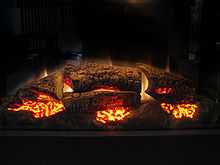Electric fireplace

An electric fireplace is an electric heater that mimics a fireplace burning coal, wood, or natural gas. Electric fireplaces are often placed in conventional fireplaces, which can then no longer be used for conventional fires. They plug into the wall, and can run on a "flame only" setting, or can be used as a heater, typically consuming 1.4-1.6 kW, that can heat a 400 sq ft (37 m2) room.[1]
History
Techniques for electrical "flame effects" have been around since at least 1981.[2]
Commercial electric fireplace techniques include the Optiflame, introduced in 1988 by Dimplex.
Dimplex claims[3] to have produced the first electric fireplace with a "realistic" wood-burning flame effect in 1995. It is unclear what specific technique is being referred to, although it may be U.S. Patent 5,642,580.
Advantages compared to traditional fireplaces
Advantages of electric fireplaces are that they:
- do not require chimneys;
- are often portable;
- do not require remodeling to install.
Disadvantages compared to traditional fireplaces
Disadvantages of electric fireplaces are that they:
- are often less efficient[citation needed], because of the inefficiency in generating electricity;
- cost more to buy than typical electric heaters;
- are not as realistic as real flames, even in gas fireplaces;
- cannot be exposed to weather.
See also
References
- ↑ http://www.dalefireplaces.co.uk/pages/efficient-electric-fires.aspx
- ↑ U.S. Patent 4,253,045 Flickering flame effect electric light controller
- ↑ http://www1.dimplex.com/aboutdimplex.aspx